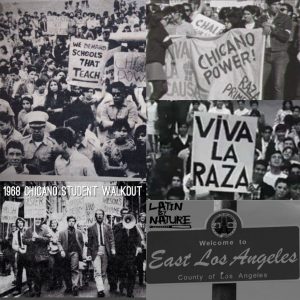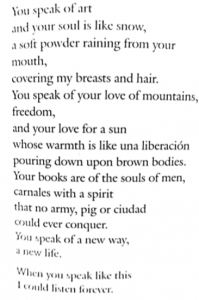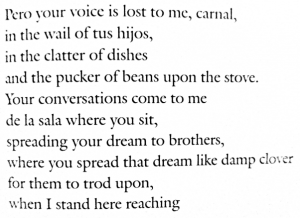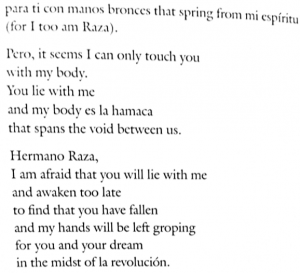 During the late sixties, Mexican- Americans, Chicanos, began mobilizing against the treatment they received in institutional facilities, such as public education and workplaces (“Chicano Movement”). In 1968, there were several high school walkouts in Los Angeles to protest the substandard education these young Chicanos were receiving (Sahagun, “East L.A., 1968“). During the 1969 First National Chicano Youth Conference in Denver, there was a workshop concerning the status of Chicanas within the movement, and it ” ‘was the consensus of the group that the Chicana woman does not want to be liberated’ ” (Vidal 22).This was one of the actions that spurred Chicanas into action. Chicanismo–ethnic pride–was a predominantly masculine ideology. This is apparent in short films, such as “I am Joaquin” and “Yo Soy Chicano” where women were portrayed as abstractions of Mother Earth or symbols of fertility while the men were portrayed as embodiments of revolutionary warriors (Fregoso 12). Chicanas were excluded from the early beginnings of the Chicano and the Second Wave Feminist Movements. It became apparent that Chicanas needed to create a space to air their unique grievances. This space was found in the poetry and other writings produced during the era.
During the late sixties, Mexican- Americans, Chicanos, began mobilizing against the treatment they received in institutional facilities, such as public education and workplaces (“Chicano Movement”). In 1968, there were several high school walkouts in Los Angeles to protest the substandard education these young Chicanos were receiving (Sahagun, “East L.A., 1968“). During the 1969 First National Chicano Youth Conference in Denver, there was a workshop concerning the status of Chicanas within the movement, and it ” ‘was the consensus of the group that the Chicana woman does not want to be liberated’ ” (Vidal 22).This was one of the actions that spurred Chicanas into action. Chicanismo–ethnic pride–was a predominantly masculine ideology. This is apparent in short films, such as “I am Joaquin” and “Yo Soy Chicano” where women were portrayed as abstractions of Mother Earth or symbols of fertility while the men were portrayed as embodiments of revolutionary warriors (Fregoso 12). Chicanas were excluded from the early beginnings of the Chicano and the Second Wave Feminist Movements. It became apparent that Chicanas needed to create a space to air their unique grievances. This space was found in the poetry and other writings produced during the era.
In 1975, Lorna Dee Cervantes wrote “Para un Revolucionario,” highlighting the disconn ect within the Chicano Movement and its actions towards Chicanas. Cervantes at first describes the language and rhetoric of the Chicano Movement in a positive tone. Words such as sun, soft, warmth, and love all have positive connotations. Cervantes is mesmerized by the Chicanos’ proclamation of liberation for la Raza* as she proclaims, “When you speak like this / I could listen forever.”
ect within the Chicano Movement and its actions towards Chicanas. Cervantes at first describes the language and rhetoric of the Chicano Movement in a positive tone. Words such as sun, soft, warmth, and love all have positive connotations. Cervantes is mesmerized by the Chicanos’ proclamation of liberation for la Raza* as she proclaims, “When you speak like this / I could listen forever.”
Then, however, the poem takes a drastic shift in tone regarding its subject, El Chicano. Cervantes begins this stanza by stating “Pero your voice is lost to me, carnal.” It was typical of Chicana poets to smoothly transition between English and Spanish as it illustrated the bilingual and bicultural aspect of their identity. The use of carnal is significant because i t signals the recognition of the masculine undertones within the movement. Carnal, blood in Spanish, was frequently used among Chicanos to mean brother/brotherhood. Cervantes then proceeds by listing the attributes of the domestic sphere–cooking, cleaning, child tending– to highlight the Chicana’s position in the household, as well as to indicate her isolation in the movement. The Chicana wants liberation, as well, but she is trapped within the confines of her traditional gender role. She can listen to the Chicanos talk about the revolution in la sala**, but she is prohibited from joining. This portion of the poem highlights the exclusion and sexism present in the Chicano Movement.
t signals the recognition of the masculine undertones within the movement. Carnal, blood in Spanish, was frequently used among Chicanos to mean brother/brotherhood. Cervantes then proceeds by listing the attributes of the domestic sphere–cooking, cleaning, child tending– to highlight the Chicana’s position in the household, as well as to indicate her isolation in the movement. The Chicana wants liberation, as well, but she is trapped within the confines of her traditional gender role. She can listen to the Chicanos talk about the revolution in la sala**, but she is prohibited from joining. This portion of the poem highlights the exclusion and sexism present in the Chicano Movement.
Cervantes re-emphasizes the prevalence of sexism within th e movement in the following excerpt. Cervantes states that she “can only touch [him] with [her] body.” Chicanas were seen as sexual objects, not respectable equals. The last stanza is meant to be read as a warning. The Chicano Movement will fail if it continues to exclude Chicanas from the conversation. It is clear that Cervantes does not want the movement to fail with lines such as “my hands will be left groping / for you and your dream,” but the dream of the revolution will be lost if Chicanas are not adequately represented. How can these men, these Chicanos, proclaim to fight for the liberation of la Raza when they exclude half of it?
e movement in the following excerpt. Cervantes states that she “can only touch [him] with [her] body.” Chicanas were seen as sexual objects, not respectable equals. The last stanza is meant to be read as a warning. The Chicano Movement will fail if it continues to exclude Chicanas from the conversation. It is clear that Cervantes does not want the movement to fail with lines such as “my hands will be left groping / for you and your dream,” but the dream of the revolution will be lost if Chicanas are not adequately represented. How can these men, these Chicanos, proclaim to fight for the liberation of la Raza when they exclude half of it?
*the race
**the living room
Sources:
Cervantes, Lorna D. “Para un Revolucionario.” Infinite Divisions: An Anthology of Chicana Literature. Edited by Tey Diana Rebolledo and Eliana S. Rivero, University of ArizonaPress, 1993.
“Chicano Movement.” Educating Change, 22 June 2005, http://www.brown.edu/Research/Coachella/chicano.html. Accessed 26 November 2018.
Fregoso, Rosa Linda. The Bronze Screen: Chicana and Chicano Film Culture. University of Minnesota Press. 2003.
Sahagun, Louis. “East L.A., 1968: ‘Walkout!’ The day that high school students help ignite the Chicano power movement.” Los Angeles Times, 01 March 2018.
Vidal, Mirta. “New Voice of La Raza: Chicanas Speak Out*.” Chicana Feminist Thought: The Basic Historical Writings. Edited by Alma M. García, Routledge, 1997.
